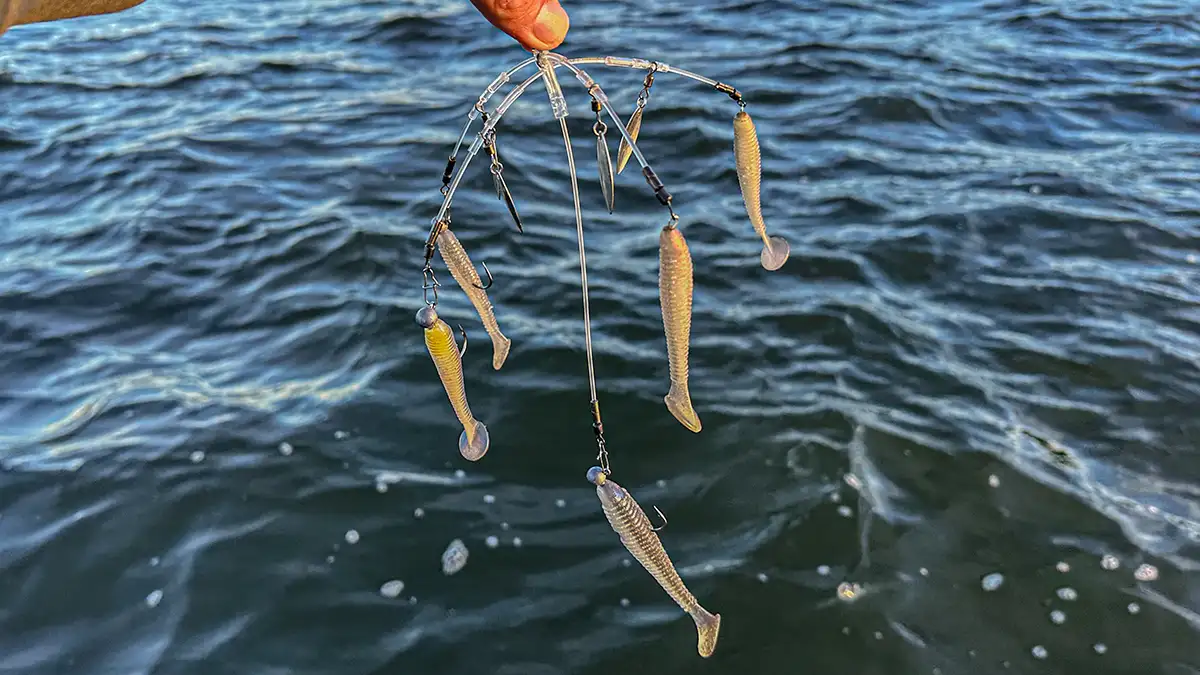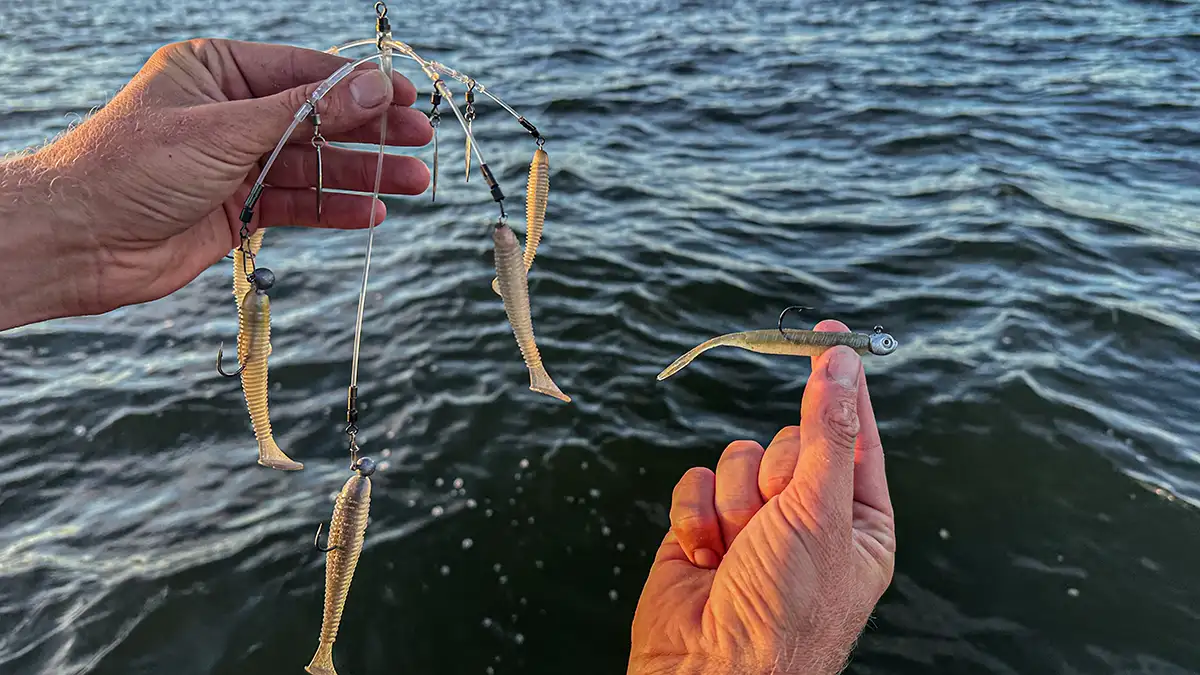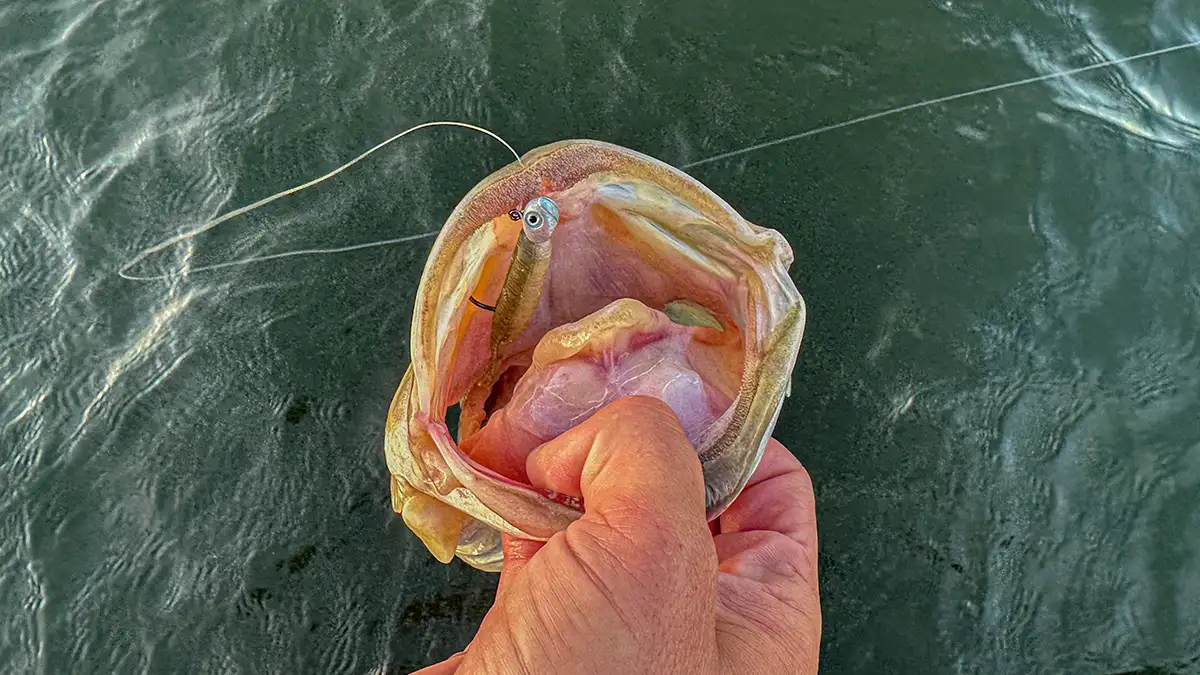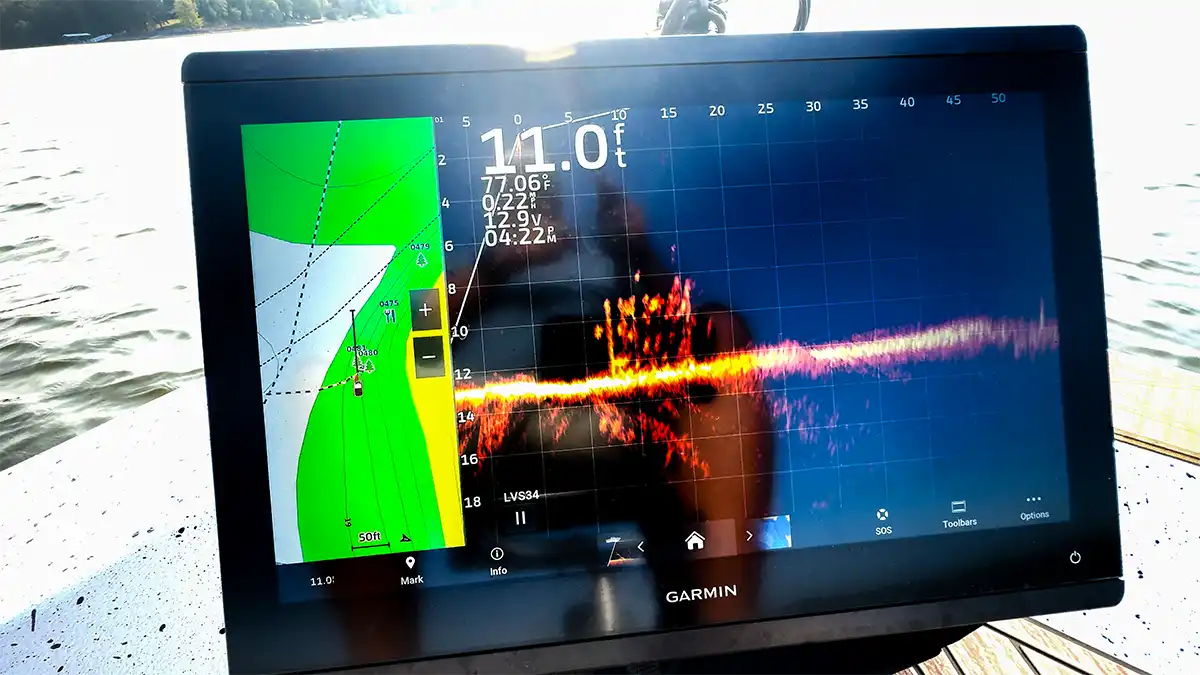Warning: Undefined variable $k in /home/nginx/domains/wired2fishcom.bigscoots-staging.com/public/wp-content/themes/understrap-child-0.6.0/functions.php on line 984
Warning: Undefined variable $k in /home/nginx/domains/wired2fishcom.bigscoots-staging.com/public/wp-content/themes/understrap-child-0.6.0/functions.php on line 987
With water temperatures quickly dropping, fish are and will be quickly transitioning into their winter patterns. There are numerous ways to catch bass this time of year, however two rigs that consistently perform are a Damiki rig and an Alabama Rig. Both of these rigs are great for generating reaction bites in cold water conditions. With the increase in popularity surrounding live and forward facing sonar, these baits have become especially productive this time of year. This technology allows you to target specific fish at a variety of different depth ranges. While both lures are effective when paired with this technology, it is hard to differentiate when to use Alabama rigs vs Damiki rigs. This feature highlights when to use each lure based on legality, profile, sonar return, drawing power and presentation.

LEGALITY
Legality is likely the biggest factor in deciding whether to throw an Alabama or Damiki rig. An Alabama rig is banned in all Bassmaster tournaments as well as many other prominent trails. States also have varying regulations highlighting how many hooks are allowed on this type of lure. These regulations were put in place due to the productive nature of this bait. The Alabama rig’s design allows you to catch five fish on one single cast, often making it an unfair advance in many tournament scenarios.
In the state on Alabama, you are only allowed three hooks per line. This means on a five prong Alabama rig, two of the baits must be dummies with no hooks attached. It is extremely important to check both state and tournament regulation when throwing this bait on your local body of water. While the Alabama rig is illegal in many tournament trials, the Damiki rig is legal in all states and tournament trails across the country. Both baits are fished in similar scenarios, however fish react differently to them based on the baits profile, drawing power and presentation.

PROFILE DIFFERENCES BETWEEN ALABAMA RIG VS DAMIKI RIG
Both the Alabama and Damiki rig are meant to imitate small baitfish. While they are designed to imitate similar forage, the profile of these baits are quite different. A Damiki rig consists of a singular jighead and straight tail minnow. Some of the more popular Damiki rig baits include the Picasso Lures Speed Drop and a Strike King Baby Z too. This is a finesse style bait that is perfect for targeting sluggish fish that don’t want to travel long distances for a bait.
Live sonar allows you to put this bait right on the fish’s nose which is crucial for catch bass in freezing temperatures. This bait shines when fish are in cold water and looking for a finesse style presentation. I’ve found the most success with this bait when targeting suspended spotted bass relating to ditches and bait balls.
Another advantage this bait has over the Alabama rig is that you’re able to fish it vertically. In order to work an Alabama rig properly, you must cast it away from the bait and reel it back in order to generate action from the paddle-tail swimbaits. A Damiki rig however can be dropped directly beneath the bait and jigged manually in order to generate action. This is great for targeting fish on 2D sonar or any other scenario where fish congregate under the boat.
While the Damiki rig is great for sluggish fish and vertical fishing, the Alabama rig shines in fairly similar scenarios. Some of the more popular Alabama rig baits are the YUM Yumbrella Flash Mob Junior, and a Keitech 3.3-inch Swimbait. Locations such as ditches, brush piles and suspended fish are all high percentage locations to throw this bait. I tend to opt for the Alabama rig when fish are grouped up and actively feeding. This lure allows you to catch multiple fish out of a school on a single cast, making this a deadly bait for fishing bait balls and other locations where fish congregate.
Making long casts over suspended fish is one of the more productive ways to get bit when throwing this bait. You can also vary the sizes of your jig heads in order to fish different depths. Adding heavier heads allows you to burn the bait quickly while keeping your bait low in the water column. This is often my go to bait when fish are chasing shad throughout the winter months.

DRAWING POWER OF ALABAMA VS DAMIKI
One big factor that differentiates these baits is drawing power. Larger lures with more water displacement inherently have more drawing power. Water clarity also plays a big role in drawing power as well. The further away a fish can see your lure, the more drawing power that bait has.
I opt for the Alabama rig when fishing in stained or dirty water conditions. The blades and paddle tail swimbaits found on most Alabama rigs displace a ton of water, making it easy for fish to locate the bait in low visibility conditions. This is crucial when targeting bass in muddy or stained water. A Damiki rig on the other hand displaces very little water, making it hard for fish to locate the bait without good visibility.
I opt for the damiki rig in ultra clear water scenarios. This bait’s lifelike profile seems to trigger more fish in clear water scenarios due to its natural presentation. An Alabama rig often generates a ton of followers in the scenario, but the added wires and blades will often keep fish from committing. Moving these baits at high speeds is imperative for getting fish to bite on clear water fisheries such as Lake Lanier.

RETURN ON LIVE SONAR
Return on live sonar is another factor that differentiates these baits. An Alabama rig is much larger, this generates a much greater return on live sonar. This is great for people who are just getting into using this type of technology, as it makes finding the bait much easier. This is how I first got comfortable with live sonar. I started by almost strictly using an Alabama rig until I got comfortable finding my bait. I was then able to transition to smaller lures without as much of a learning curve.
On the other hand, a Damiki rig is much more difficult to locate on live sonar. Outside of having experience with this type of technology, there are a few things you can do to help locate your bait on live sonar. One of the best ways to increase you sonar return is by using a tungsten jig head. This higher density material shows up much brighter on the screen making it much easier to locate. You can also increase the gain on your fish finder, this will increase the overall disturbance as well as your lures return.

PRESENTATION
Presentation is another crucial component to having a successful day on the water throwing these lures. Through the use of live sonar we are able to watch how fish react to the bait, making it easy to find the correct presentation these fish are looking for. While these lures are different from one another, they are fished in very similar ways.
When throwing an Alabama rig, there are a few nuances that can really help you catch more fish. One of the biggest is keeping the bait above the fish. Bass like to feed upwards, so it is important not to let the bait sink beneath the fish. This will often spook the bass and keep them from committing to your bait. Varying your speed is another great way to get fish to commit. Once a bass locates the lure, I will then speed up my retrieve. This keeps the fish from getting a good look at your bait, while simultaneously imitating a fleeing baitfish. Quickly ripping this bait past individual fish is an extremely productive way to put fish in the boat this time of year.
You can fish a Damiki rig very similar to an Alabama rig, however there are still a few tricks you can implement to catch more fish than the next guy. The first and arguably most important part of throwing a Damiki rig is distance. With increased fishing pressure, fish have become very accustomed to seeing lures and boats. Keeping your bait far away from the boat is your best chance at getting these wary fish to commit. Once the fish sees your boat, they become aware of your presence and much harder to catch.
Next I like to vary my speed and presentation. Much like an Alabama rig, I will speed up my retrieve once a fish starts to follow. This will keep fish from getting a good look at your lure as well as simulate a baitfish getting away. I also like to slightly shake the bait throughout the retrieve, creating a secondary tail action that gives this bait a lifelike action. There are tons of ways to present your Damiki rig, however this is the method I’ve found the most success doing.
There is no wrong answer when choosing between and Alabama rig vs Damiki rig. Both lures are great options for generations reaction strikes in cold water scenarios. While both baits are successful, there are advantages to each bait based on drawing power, sonar return and presentation. If your looking for a bait to target fish with this winter, the Alabama rig and the Damiki are two baits you must have in your arsenal.












